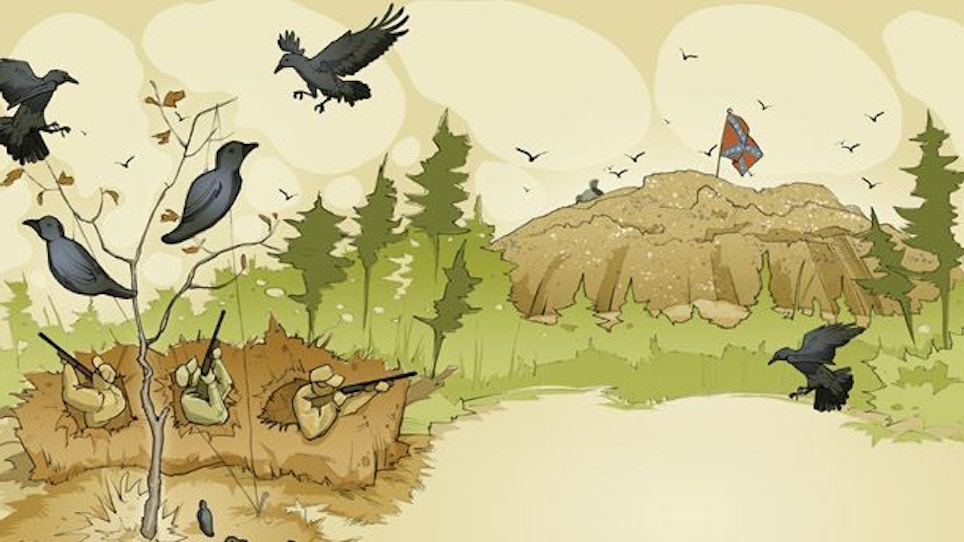The gray light of dawn fills in the details around our blind as my partner and I listen for the distant caws of crows. Decoys, staked in the baked clay in front of us, are motionless in the still July air, and a sentry-bird decoy hangs from a line in the tree above us. The trap is set — now we wait.
Soon, the morning’s first caw comes from over the hill to the southeast. Seconds later, another caw sounds out from the same direction, only closer. I raise the well-worn wooden call to my lips and send out an inviting “come-here” — cawww, cawww, cawww. It’s soon answered and a single bird clears the pines on the hilltop above. It begins to lose altitude as it slows its wing beats in anticipation of landing among its counterfeit brethren. Tucked deep within the brush pile left from a timber harvest a year earlier, we wait, motionless, as the bird continues its final approach. The jet-black crow closes the distance, swoops in and lands among our spread. One shot rings out and one crow is in the bag!
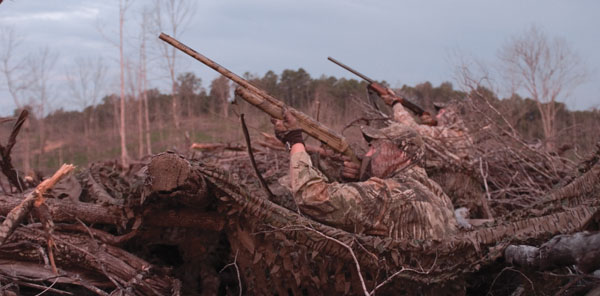
The Crow’s Ultimate Food Source
That steamy July morning in central Alabama was our first crow hunt on a new lease. I anticipated this hunt more than any before. For one reason, the county landfill on the property next door attracted hundreds of crows from miles around and we were in the middle of the flight path from a roost to the “mess hall.” That morning we killed 26 crows in 1½ hours and ran out of shells. Over the next six weeks we hunted that honey hole twice more, killing a total of 91 crows.
In the Beginning
My dad gave me my first crow call for Christmas when I was about 10, a hand-held bellow-type call that worked like an accordion. I didn’t call in many crows with that call, but it began my obsession with calling the curious birds. The next Christmas, my younger brother and I got wooden Faulk’s mouth-blown calls and a bag of two-dozen crow decoys. By 10 a.m. Christmas morning, we had all 24 decoys staked in the front yard and were hiding behind a woodpile, calls in hand. We sent out our best attempts and within seconds had several noisy crows circling above. Soon, there were nearly 50 crows heckling our decoys below. From then on I was hooked.
In the early years, my dad and I would set out decoys midday after a morning of squirrel hunting. We might kill one or two, but that was the extent of our crow hunting for the next 15 years. Back then we did a lot of running and gunning and just hid in the brush. We didn’t put our heart and soul into setups and the number of crows we killed reflected that.
Years later, in college, I would build blinds for my hunting buddies and me to hunt from. We set out decoys before daylight and sat tight calling to passing crows. We killed a few, but not the numbers that guys like Jerry Tomlin were killing on crow-hunting videos. That all changed when I found my crow hunting paradise next to the landfill.
Serious Scouting
I approached it like scouting for deer, turkey, or coyote. I scouted mornings and evenings, parking and glassing from the tallest ridges and watching the crows flying from the roost to the landfill and back. On this property, a group of more than 300 crows leave the roost in the mornings and head straight to the landfill. Around 9 a.m., they fly back to the roost. Afternoons, around 2:30, it’s back to the landfill to feed, and then 45 minutes before dark they fly back to the roost (a pine thicket on an adjacent property).
Scouting revealed that at daybreak the crows would filter into the landfill in small groups, not 300 at once, allowing us to call singles, doubles and triples. Smaller groups are better, because you can shoot the one or two birds before the others get into sight and spook. This is a great method for killing a lot of crows in one murder. Calling in large numbers of birds at the same time educates the ones that make it out alive, creating call-shy birds for future hunts.
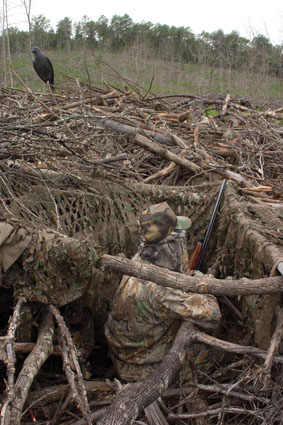 The Ambush
The Ambush
A crow’s ability to spot something out of place is unbelievable. They can see the slightest movement and pick out the faintest bit of exposed skin. Any camouflage will work as long as you are covered from head to toe and the blind hides you and your gear.
The best blinds are made of natural materials found in the location you’ll hunt, since these materials blend best with the natural surroundings. The blind should allow you to sit or stand and still be concealed. If your blind is too low to the ground it won’t cover your outline and movements. If it’s too tall you might have difficulty seeing incoming birds and taking shots. The blind material should be in close to your body, only allowing enough movement to turn around, stand, and retrieve shells, etc. This keeps you concealed from high-flying overhead birds when they circle before committing.
The blind we used was in place prior to the hunt, a large brush pile of treetops on a logging deck, left behind after the timber company clear-cut around our lease. A week before the hunt I cleared out four holes in the brush pile for shooters, stacking the removed limbs around the top of each hole. Once these were formed, camo netting around the tops with some additional branches formed a tight fit over each hole concealing us from overhead birds.
Safety was a big priority in designing the setup. The cubbyholes in our blind were evenly in a line. All four shooters would be facing south, the direction the crows would come from on their flight to the landfill. The left-most shooter would shoot birds coming in from the east and the right-side shooter any birds to the west. All four shooters had shots at birds front and behind. Our decoys were set so the crows would be lured directly in front of all four shooters. This allowed us to kill most of the birds coming into the setup. Often, missed crows will fly to the nearest tree line and send out warning calls, which spook away new arrivals.
Decoy For Deception
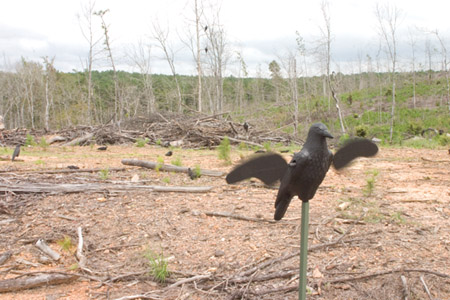 If your blind is set up properly, you’re covered in camo, and you’ve done your scouting, your decoys will do the rest of the work for you. I don’t call much. I’ll call to distant crows to turn them my way and might call once or twice after they commit to keep their confidence up, but once a crow is on it’s way I shut up and let the decoy spread do the dirty work.
If your blind is set up properly, you’re covered in camo, and you’ve done your scouting, your decoys will do the rest of the work for you. I don’t call much. I’ll call to distant crows to turn them my way and might call once or twice after they commit to keep their confidence up, but once a crow is on it’s way I shut up and let the decoy spread do the dirty work.
There is nothing fancy about my spread, but there are a few components I feature in every one. I always make sure there is a dead or leafless tree within 30 yards of my blind, preferably, directly in front. This tree serves as the best confidence booster of all, because it’s where the sentry decoy hangs. Whenever you pass a field with a group of crows feeding, you’ll notice one or two birds sitting in a tree not far from the group. These watch for approaching danger from an elevated position. If a predator or hunter is spotted they sound the alarm and send the others flying for cover. By including this decoy in your spread you’re showing crows that approach that everything is safe. Also, this high decoy can be seen from a long distance, so make sure to get it as high in the tree as you can. I often use two sentry decoys per spread.
Most decoys have a loop on the back so you can tie string to it. Attach a heavy lead sinker to the tag end of some thick fishing line, with the remaining line still on the spool. Toss the sinker end of the line over the highest limb possible, let it fall back to the ground, remove the sinker and tie the decoy to that end of the line and hoist it up against the hanging limb. Finally, cut the remaining line from the spool, leaving enough line to tie around the tree. Use clear fishing line rated for 30-pound-test or more. The thicker line can withstand the abrasive tree limb when hoisting the decoy. Be sure to take the line with you when you leave.
Next, stake the decoys (about 20) into the ground in front of the blind. There is no special pattern, but face the birds in different directions and space them out in an area about 30 yards in diameter. This resembles a group of feeding crows, which lets incoming crows know that the area is safe and contains food. Try to keep the decoys 15 to 20 yards out from the blind so you don’t draw attention to it. You can use your decoys as a range indicator. If 40 yards is your shooting comfort zone, keep the outer decoys at that range.
I do the majority of my crow hunting from spring through late summer, which allows me to get in some great hunting action while everyone else is waiting for the fall. Start scouting now for your next crow-hunting Mecca.
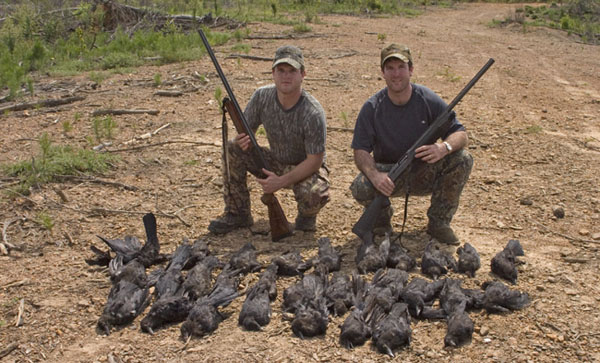
Check out our newest crow hunting video "Public Enemy No.1 : The Crow" on our VIDEO PAGE.
